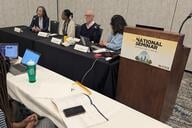You have /5 articles left.
Sign up for a free account or log in.
WASHINGTON – What would international students in American classrooms most want their professors to do differently?
A survey of 662 international students at 23 colleges and universities commissioned by ELS Educational Services found that many international students want their professors to:
- Provide more feedback (35 percent identified this as a desired improvement from among a given list of choices).
- Seek to understand international students’ perspectives (33 percent).
- Make classroom materials available after class (32 percent).
- Provide examples of completed assignments (32 percent).
- Provide non-U.S. examples in course contents (28 percent).
One caveat for the above numbers is that nearly 12 percent of students in the sample were native English speakers, so their presence in the sample could have skewed some of the overall figures in various ways. For example, 22 percent of all respondents said they'd like their professor to speak more slowly or clearly, while 32 percent of Chinese respondents did.
The sample was nearly evenly split between undergraduates (52 percent) and graduate students (48 percent). The most common classroom challenges identified by the students who were surveyed were: too many writing assignments (65 percent said this was a challenge), too much reading (cited as a challenge by 63 percent of respondents), writing in English (56 percent), participating in class presentations (56 percent), the perceived preferential treatment of native speakers (56 percent), participating in class discussions (56 percent) and professors’ lack of understanding of their culture (50 percent).
More than a third of students -- 35 percent -- said they felt uncomfortable questioning the opinions of their professors, 30 percent said they felt uncomfortable questioning the opinion of their peers, and 29 percent said they felt uncomfortable speaking in class discussions (the latter proportion was higher among Chinese students, 38 percent of whom said they felt uncomfortable). Nearly a quarter of respondents -- 24 percent -- said they felt uncomfortable interacting with American students.
Mark W. Harris, the president emeritus of ELS, presented on the findings of the survey during a session Tuesday at the Association of International Education Administrators should this be Association of International Education Administrators? dlugh, yes. thank you. er annual conference focused on how faculty can “bridge divides” and integrate international students in the classroom. The number of international students in the U.S. has nearly doubled in the past 10 years and now exceeds 1 million, representing about 5 percent of the total student population, according to data from the Institute of International Education.
Recruiting international students was the number one priority for university internationalization identified by institutions who responded to the American Council on Education’s 2016 survey on mapping campuswide internationalization, which the association conducts every five years. In presenting a preview of some of the 2016 data – a full report on the survey is scheduled to be released this spring -- Robin Matross Helms, the director of ACE’s Center for Internationalization and Global Engagement, said that one key finding is that there’s been a “backtracking” in terms of support for internationalization-focused faculty development opportunities from the 2011 to 2016 surveys. The percentage of responding colleges and universities that reported offering these kinds of opportunities was lower in 2016 than in 2011.doug, revised this last sentence as the original was not written esp. clearly er
About a quarter of institutions report offering workshops for faculty on teaching and integrating international students -- “my response was, wow, only a quarter?” Helms said.
“If we’re not providing faculty with that professional development support, that’s definitely a worrisome trend,” Helms said.
Darla K. Deardorff, AIEA’s executive director and an adjunct research scholar at Duke University’s education program, described the different forms faculty development can take – retreats, discussion working groups, invited speakers, faculty panel presentations – with common topics being things like: "classroom challenges for international students," "moving beyond stereotypes and assumptions," "integrating non-Western perspectives into what is taught," "communicating with international students," "creating a supportive classroom environment," "learning styles in different cultures," "understanding classroom behavior," and "interculturally competent teaching."
Deardorff also shared recommendations to faculty international students have made in various focus groups she’s conducted with them. Recommendations include:
- to focus on the professor-student relationship
- to understand what students are used to (and not to assume)
- to be very clear on expectations and to provide examples
- to pay attention to underperforming students
- to be intentional about connecting domestic and international students in the classroom
- to not single out international students (by asking, say, “you’re from Australia, what do Australians think of this?”)
- to connect students with various campus resources available, such as the writing center
- to use examples from students’ home countries.
“A lot of this we know, but it’s nice to hear it reaffirmed by the students,” Deardorff said.




